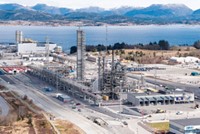Advertisement
Grab your lab coat. Let's get started
Welcome!
Welcome!
Create an account below to get 6 C&EN articles per month, receive newsletters and more - all free.
It seems this is your first time logging in online. Please enter the following information to continue.
As an ACS member you automatically get access to this site. All we need is few more details to create your reading experience.
Not you? Sign in with a different account.
Not you? Sign in with a different account.
ERROR 1
ERROR 1
ERROR 2
ERROR 2
ERROR 2
ERROR 2
ERROR 2
Password and Confirm password must match.
If you have an ACS member number, please enter it here so we can link this account to your membership. (optional)
ERROR 2
ACS values your privacy. By submitting your information, you are gaining access to C&EN and subscribing to our weekly newsletter. We use the information you provide to make your reading experience better, and we will never sell your data to third party members.
Energy
More Funding For High Risk Energy Research
Round Two: $106 million in grants will be distributed for 37 new projects selected
by Jeff Johnson
May 4, 2010
The second round of Department of Energy advanced technology research grants, worth $106 million, were awarded to 37 educational, government, and private consortia late last week. The Advanced Research Projects Agency-Energy (ARPA-E) funding grants are intended to spur development and commercialization of new technologies that could fundamentally transform the way the U.S. uses and produces electricity, says DOE, which oversees the program.
"These projects," Energy Secretary Steven Chu said, "show the U.S. can lead the next Industrial Revolution in clean energy technologies." Despite great potential, the fledgling technologies carry risks so high that private investors are unwilling to support them at an early stage of development.
This round's winning projects are in three main areas: using electricity rather than photosynthesis to produce biofuels (13 projects worth $41.2 million); electric transportation battery technologies (10 projects worth $34.5 million); and technologies for capturing carbon from the emissions of coal-fired power plants (14 projects worth $30.6 million).
Most of the projects have several partners that include universities, companies, and even DOE labs in the mix. Looking only at each project's lead recipient, 57% (21 projects) are run by educational institutions, 24% (nine projects) are led by small businesses, 11% (four projects) are directed by DOE national labs, and 8% (3 projects) are led by large corporations. This round shows a shift from the first round in which educational institutions led 38% of the projects, small companies directed 43%, and large corporations led 19%. Government labs were not allowed to lead first round projects.
In the second round, Massachusetts Institute of Technology was the largest winning institution with four projects valued at $10.9 million; next came Lawrence Berkeley National Laboratory with two projects and $7.6 million in total grants.
The projects are in some 17 states and vary in size from two at $6 million each to one at $543,000. The largest projects include one led by OPX Biotechnologies Inc. of Boulder, Colo., which aims to develop an engineered microorganism that can produce a biodiesel-equivalent fuel from hydrogen and carbon dioxide, and the other by Boston's Ginkgo BioWorks, which intends to use E. coli to convert electrical energy and CO2 into alkanes and on to isooctane.
The smallest grant went to Columbia University to use engineered bacteria to produce isobutanol from CO2.
DOE received 540 concept papers in this second round. Of these 180 were asked to prepare full applications, which were reviewed by scientists in and out of the department and trimmed to the final 37 projects. ARPA-E officials and project staff are now negotiating details, as winners work to raise and add the required 20 to 50% to the grant amount.
The ARPA-E program was established by Congress in 2007 but not funded until a year ago when the Obama Administration provided $400 million for the program from the American Recovery & Reinvestment Act of 2009. During the first round of grants last year, DOE was swamped with 3,700 project applicants seeking $151 million in funds. The agency wound up funding 37 projects (C&EN, Jan. 4, page 19).
ARPA-E has one more round in the works for summer. For this third round, $100 million will be provided to investigate grid-scale electricity storage technologies, advanced power converters, and advance energy-efficiency cooling technologies. The agency is now assessing these project applications (C&EN, March 22, page 38).




Join the conversation
Contact the reporter
Submit a Letter to the Editor for publication
Engage with us on Twitter